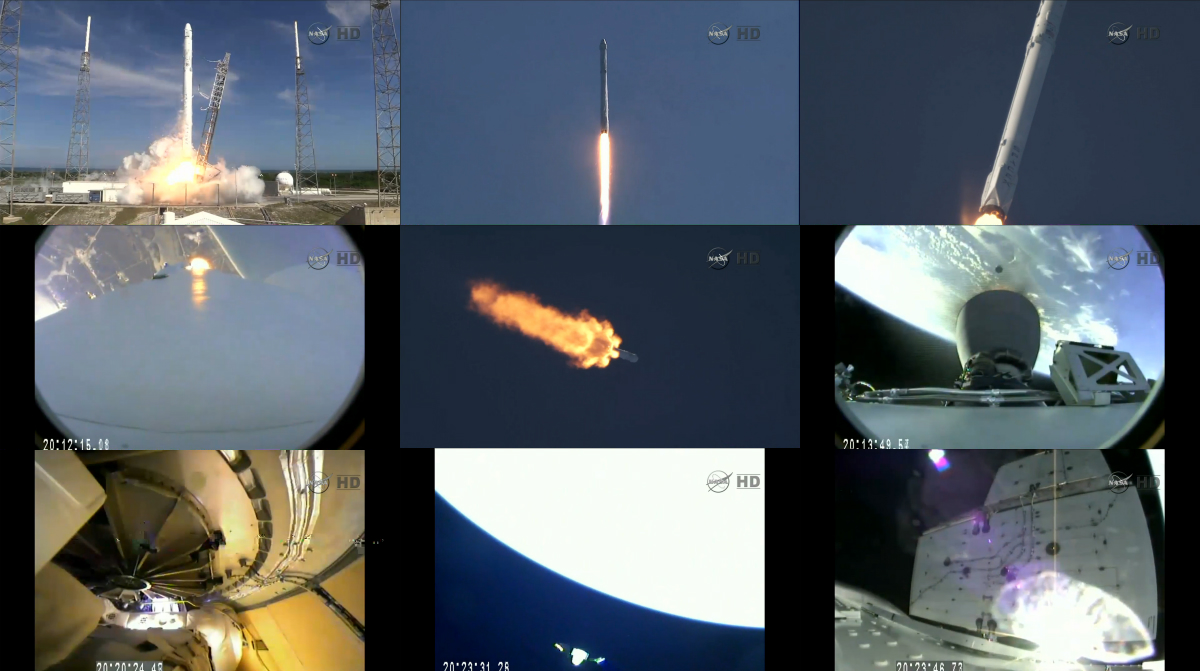Research that will help prepare NASA astronauts and robotic explorers for future missions to Mars is among the two tons of cargo now on its way to the International Space Station (ISS) aboard SpaceX’s Dragon spacecraft. The spacecraft launched on a Falcon 9 rocket at 4:10 p.m. EDT Tuesday, April 14 from Space Launch Complex 40 at Cape Canaveral Air Force Station in Florida.
“Five years ago this week, President Obama toured the same SpaceX launch pad used today to send supplies, research and technology development to the ISS,” said NASA Administrator Charles Bolden. “Back then, SpaceX hadn’t even made its first orbital flight. Today, it’s making regular flights to the space station and is one of two American companies, along with The Boeing Company, that will return the ability to launch NASA astronauts to the ISS from U.S. soil and land then back in the United States. That’s a lot of progress in the last five years, with even more to come in the next five.”
The mission is the company’s sixth cargo delivery flight to the station through NASA’s Commercial Resupply Services contract. Dragon’s cargo will support approximately 40 of the more than 250 science and research investigations that will be performed during Expeditions 43 and 44, including numerous human research investigations for NASA astronaut Scott Kelly’s one-year mission in space.
Science payloads will support experiments in biology, biotechnology, physical science and Earth science — research that improves life on Earth and drives progress for future space exploration. Investigations include:
- A study of potential methods for counteracting cell damage that occurs in a microgravity environment
The Cell Shape and Expression research program will provide for the first time a reliable experimental model able to highlight the relationships between microgravity, cell shape and gene expression, which may also inform pharmacological ways to counteract microgravity-induced cell damages.
- Research to improve understanding of bone cells, which could lead to treatments for osteoporosis and muscle wasting conditions
Osteo-4 studies the effects of microgravity on the function of osteocytes, which are the most common cells in bone. These cells reside within the mineralized bone and can sense mechanical forces, or the lack of them, but researchers do not know how. Osteo-4 allows scientists to analyze changes in the physical appearance and genetic expression of mouse bone cells in microgravity.
- Continued studies into astronaut vision changes
Dragon also will deliver hardware to support an ongoing one-year crew study known as Fluid Shifts. More than half of American astronauts experience vision changes and alterations to parts of their eyes during and after long-duration spaceflight. The Fluid Shifts investigation measures how much fluid shifts from the lower body to the upper body, in or out of cells and blood vessels, and determines the impact these shifts have on fluid pressure in the head and changes in vision and eye structures.
- Tests on a new material that could one day be used as a synthetic muscle for robotics explorers of the future
Robots can perform tasks too repetitive, difficult or dangerous for humans. Robots built with synthetic muscle would have more human-like capabilities, but the material would have to withstand the rigors of space. This investigation tests the radiation resistance of an electroactivepolymer called Synthetic Muscle, developed by RasLabs, which can contract and expand like real muscles.
The spacecraft also will deliver hardware needed for the installation of two International Docking Adapters scheduled for delivery on future SpaceX missions. Once installed, these adapters will enable commercial crew spacecraft to dock to the space station.
ESA (European Space Agency) astronaut Samantha Cristoforetti will use the space station’s robotic arm to grapple Dragon to the station at 7 a.m. Friday, April 17. Expedition 43 Commander Terry Virts of NASA will assist.
After about five weeks, Dragon will depart the space station for a splashdown in the Pacific Ocean west of Baja California. The capsule will return more than 3,000 pounds of science, hardware, crew supplies and spacewalk tools.
The International Space Station is a convergence of science, technology and human innovation that enables us to demonstrate new technologies and make research breakthroughs not possible on Earth. It has been continuously occupied since November 2000 and, since then, has been visited by more than 200 people and a variety of international and commercial spacecraft. The ISS remains the springboard to NASA’s next giant leap in exploration, including future missions to an asteroid and Mars.
For more information about International Space Station science and research, visit:
https://www.nasa.gov/station
For more information about the SpaceX resupply mission, visit:
https://www.nasa.gov/spacex
-end-
Stephanie Schierholz
Headquarters, Washington
202-358-1100
stephanie.schierholz@nasa.gov
Dan Huot
Johnson Space Center, Houston
281-483-5111
daniel.g.huot@nasa.gov


























